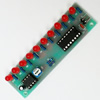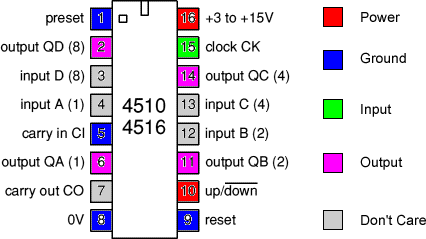6. THE NAND GATE OSCILLATOR (NGO)
38
Jan 20
Jan 20
37
Jan 18
Jan 18
36
Jan 16
Jan 16
35
Jan 12
Jan 12
34
Jan 10
Jan 10
NGO Recap Animations:
TP1, TP2, TP3, TP4
RC2-0.01uF, RC2-0.1uF
Counting Circuits (ACES' Pulse Counter)
NGO as Clock Input to the
The 4510 Up/Down (0-9) Counter
(Explore changes to RC2 components)
TP1, TP2, TP3, TP4
RC2-0.01uF, RC2-0.1uF
Counting Circuits (ACES' Pulse Counter)
NGO as Clock Input to the
The 4510 Up/Down (0-9) Counter
(Explore changes to RC2 components)
33
Dec 20
Dec 20
Polishing your Project: PCBs and Case
NGO Input - FULL
Describe: 1. At Rest, 2. Active, 3. At Rest
Prototype to Confirm
NGO Input - FULL
Describe: 1. At Rest, 2. Active, 3. At Rest
Prototype to Confirm
32
Dec 16
Dec 16
NAND Gate Oscillator (NGO)
Input - FIRST STAGE
Describe: 1. At Rest, 2. Active, 3. At Rest
Prototype to Confirm
Input - FIRST STAGE
Describe: 1. At Rest, 2. Active, 3. At Rest
Prototype to Confirm
5. DIGITAL CIRCUITS: Concepts, Components, and Tools
31
Dec 14
Dec 14
30
Dec 12
Dec 12
29
Dec 8
Dec 8
Integrated Circuits CMOS ICs
4000 Series CMOS Logic ICs
Probing the 4081: Quad 2-Input AND Gate
Example: Bistable AND Gate
4000 Series CMOS Logic ICs
Probing the 4081: Quad 2-Input AND Gate
Example: Bistable AND Gate
28
Dec 6
Dec 6
JA, RB, BC, SC, JC(e), JC(t), JC, SD, KF-A, AH, PK
SK, BL, MLeF, ML, EM, AM, DN, FP, HR, LT, YV
LOGIC (math): What you know already...
Venn Diagrams (ex: Greek, Latin, Russian Glyphs)
Unary Logic Gates: BUF (EQU) and NOT (INV)
Binary Logic Gates: AND, OR, NAND, NOR
ER Project 4:
Digital (Transistor-Based) Logic Gates
Integrated Circuits
27
Dec 2
Dec 2

p. 47
26
Nov 30
Nov 30

The Binary Game: Semi-Finals
Analog (Continuous) vs Digital (Discrete)
Review of the Decimal Number System
Digital Name Pairs
Binary Representation of Characters:
ASCII, Unicode
Analog (Continuous) vs Digital (Discrete)
Review of the Decimal Number System
Digital Name Pairs
Binary Representation of Characters:
ASCII, Unicode
4. TRANSISTORS
25
Nov 28
Nov 28

24
Nov 24
Nov 24
p. 42
23
Nov 22
Nov 22
p. 40
Falstad Applet:
Interactive Oscillator
Interactive Oscillator
Circuit 4.2. The VU Meter
Circuit 4.3. Fade In, Out
Circuit 4.3. Fade In, Out
22
Nov 16
Nov 16
p. 39
21
Nov 10
Nov 10
Preparation for Chapter 5: Binary Number System
20
Nov 8
Nov 8
19
Nov 4
Nov 4
Review of ANL PCB
 Introduction to Soldering
Introduction to Soldering
Solder long leads to your Potentiometer
Data/Media gathering from your ANL prototype
When ready: dry fit your PCB and show Mr. D.
Solder long leads to your Potentiometer
Data/Media gathering from your ANL prototype
When ready: dry fit your PCB and show Mr. D.
18
Nov 2
Nov 2
Circuit 4.0. Transistor Test
Transistor-Based Motor Direction Control
Circuit 4.1. Automatic Night Light
Transistor-Based Motor Direction Control
Circuit 4.1. Automatic Night Light
17
Oct 31
Oct 31
3. CAPACITORS
16
Oct 27
Oct 27
pp. 32-33
Circuit 3.2
Extending Fade Out
Extending Fade Out
15
Oct 25
Oct 25
pp. 31-32
Circuit 3.0
LED Fade Out
LED Fade Out
2. BUTTONS and SWITCHES: Momentary, SPST, SPDT
14
Oct 21
Oct 21
pp. 24-28

Circuit 2.2. Inverted State
Circuit 2.3. Red/Green (Bicolor) Circuit
Circuit 2.4. Morse Code
Circuit 2.6. Button Logic
Circuit 2.3. Red/Green (Bicolor) Circuit
Circuit 2.4. Morse Code
Circuit 2.6. Button Logic
11
Oct 11
Oct 11
2. BUTTONS and SWITCHES
 Fritzing Components
Fritzing Components
The Momentary Push Button
Circuit 2.0. Switched LED
The Momentary Push Button
Circuit 2.0. Switched LED
1. BACKGROUND and ESSENTIALS: Concepts, Components, and Tools
13
Oct 17
Oct 17
12
Oct 13
Oct 13
Format Painter, Styles, Headers
10
Oct 6
Oct 6
9
Oct 4
Oct 4
pp. 19-20
1. ESSENTIALS
Circuit 17. Recap
Circuit 17. Recap
8
Sep 30
Sep 30
pp. 19-20
1. ESSENTIALS
The Potentiometer and PhotoResistor
aka. OptoResistor or Light-Dependent Resistor (LDR) Circuit 1.7. LED Brightness
The Potentiometer and PhotoResistor
aka. OptoResistor or Light-Dependent Resistor (LDR) Circuit 1.7. LED Brightness
7
Sep 28
Sep 28
pp. 19-20

6
Sep 26
Sep 26
Circuits: 16-17
1. ESSENTIALS
Circuit 1.4. LED with Resistor
Voltage, Current and Power Analysis of Circuit 1.4
 Circuit Design
Circuit Design
Circuit 1.4. LED with Resistor
Voltage, Current and Power Analysis of Circuit 1.4

5
Sep 21
Sep 21
Circuits: 12-14
1. ESSENTIALS
Circuit 1.0. Do NOT Assemble
Circuit 1.1 Resistor as Load and Analysis
Circuit 1.2. The Voltage Divider (Resistors in Series)
Circuit 1.0. Do NOT Assemble
Circuit 1.1 Resistor as Load and Analysis
Circuit 1.2. The Voltage Divider (Resistors in Series)
4
Sep 19
Sep 19
Circuits: 13
3
Sep 15
Sep 15
Circuits: 11-12
1. ESSENTIALS
DMM: Digital Multimeter (Continuity)
Digital Multimeter (Continuity)
SBB: The Solderless Breadboard
DC-9V/1A Switched Mode Power Supply
2.1mm DC Barrel Jack Breadboard Adapter
Ideal Jacked Breadboard Configuration
Circuit 1.0: Do NOT Assemble
DMM:
SBB: The Solderless Breadboard
DC-9V/1A Switched Mode Power Supply
2.1mm DC Barrel Jack Breadboard Adapter
Ideal Jacked Breadboard Configuration
Circuit 1.0: Do NOT Assemble



2
Sep 13
Sep 13
0. BACKGROUND (Day 1)
Axial vs Radial Configuration of Leads
Protoyping Conventions and Build Quality
Schematic Symbols, Colours of the Rainbow
Axial vs Radial Configuration of Leads
Protoyping Conventions and Build Quality
Schematic Symbols, Colours of the Rainbow
1
Sep 9
Sep 9
TAs
RSGC ACES 16/17 Program
Distribute Circuits 10 Workbook & Toolkit
(Actual Cost for Toolkit: $89.28+HST)
Greek and Phonetic Alphabets
Powers, Prefices and Symbols
Replacement Parts available in the Lair
TEL3M ISP
Distribute Circuits 10 Workbook & Toolkit
(Actual Cost for Toolkit: $89.28+HST)
Greek and Phonetic Alphabets
Powers, Prefices and Symbols
Replacement Parts available in the Lair
TEL3M ISP
0
Sep 7
Sep 7
[ACES Culture]
































